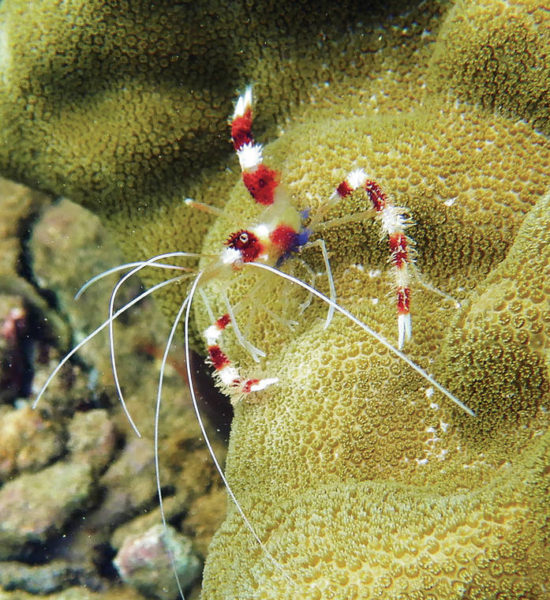Published in the Ocean Watch column, Honolulu Star-Advertiser © Susan Scott
July 6, 2019
Because my usual snorkeling site is loaded with moray eels, I rarely put my hand in a hollow to steady my body. Last week, though, when I spotted the conspicuous white antennae of a banded coral shrimp, I thought it worth the risk. Gripping the edge of the shrimp’s cave, I pulled myself down and aimed the camera.
This would scare most marine animals into backing far into their hiding place, but not this little shrimp. Instead, she came out and posed for me.
Banded coral shrimp, also called barber pole shrimp or peppermint shrimp, are some of Hawaii’s most charming reef animals. The red-and-white bands on the body and legs make them look like walking candy canes.
 Banded coral shrimp are also known as barber pole
Banded coral shrimp are also known as barber pole
and peppermint shrimp because of their red-and-white bands.
©2019 Susan Scott
If you find a female, as I did, you might see her holding to her abdomen her greenish-blue eggs.
Speaking of legs, banded shrimp have remarkable appendages. Like all shrimp, they have a total of 10. But unlike most others, this shrimp’s first three pairs of legs bear pincers.
Of the pincered pairs, the third are greatly enlarged and banded like the shrimp’s body. It’s these long, curved legs that give the shrimp their plucky air. When confronted, the animal stands tall on its pincered legs, facing even a monster-size human.
Be gentle with this spunky shrimp, though. If it feels threatened, the creature can drop its flashy legs like a gecko drops its tail. The legs grow back, but in the meantime the shrimp is handicapped.
From this colorful creature’s head flow six delicate white antennae, some of which are two to three times as long as the shrimp’s 2-inch-long body.
As if all this isn’t enough to give a snorkeler pause, there’s the shrimps’ behavior. If you slowly extend a hand toward these creatures, they often come to check you out. I once encountered one that explored my forefinger with its antennae.
This “feeling” comes from the fact that banded shrimp, and several similar species, are natural- born cleaners. The shrimp sit in their tiny caves waving their whiplike antennae to signal passing fish.
When one lingers, the shrimp touches it with the antennae until the fish becomes still. After this soothing “back rub,” the shrimp crawls over fishes’ bodies, gills and even inside mouths to eat parasites and dead tissue.
Fish seem to love this service. In my secret place, cardinalfish, surgeonfish and damselfish lingered near my banded shrimp like it was the entrance to a spa. My place is secret because coral shrimp are often collected for home aquariums. I want my shrimp to stay in their ocean home.
I’ll never tire of watching these walking peppermint sticks perform their tricks. It’s well worth sticking my hand in a hole.